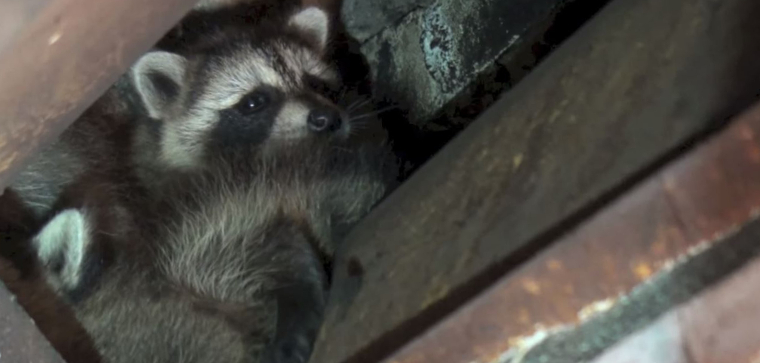-
info@aaanimalcontrol.com
Call us for help in your town
Humane Wildlife Education
What to Do With Raccoons in the Chimney
Need raccoon removal in your hometown? We service over 500 USA locations! Click here to hire us in your town and check prices- updated for year 2020.
Before we continue with how to get raccoons out of the chimney, we feel that we should tell you what NOT to do first:

> Do not light the fire. This will not encourage the raccoons to leave, especially if they are stuck in your chimney. Instead, what it will do is kill the raccoon and any kits that might be in a nest down there too. It will also send an awful stench around your home.
> Do not ignore the situation. Again, if the raccoon has gotten stuck in your chimney, it will not be able to get itself out without your help (or the help of a professional). If you ignore the raccoon(s) in your chimney, you are essentially spelling the end for them.
Now that we have told you what NOT to do, it's time to look at what you SHOULD do with raccoons in your chimney.
Is it safe for you to take a look? If it is, and you have a secondary person to help hold the ladder and keep you safe, it is worth taking a peek on the roof to see what is going on up there. If you don't have a chimney cap or yours appears to have fallen off, you will need to replace it. Pest animals are attracted by the heat of your chimney, especially during winter, so others will soon get down there once you've gotten the raccoon out.
What about the attic? In some cases, the raccoon nest is up there and the animal may have been able to get into the chimney via the attic. You should check up there and look for signs of raccoon invasions, such as poop, paw prints, etc. Holes that you spot will need to be sealed up.
Can you see the animals? This is where life gets a little complicated — you must check to see whether or not it is just one raccoon hiding away in there, or if you have a family of them. Obviously, if you have a family of them, getting them out again is going to require some pretty specific directions.
If the animal is NOT stuck, using raccoon eviction fluid can help to drive them out. The fluid smells unpleasant, so you must be prepared for your home to smell a little bad for a little while. The good news is that this stuff tends to work pretty quickly, if it is going to work at all (some repellents do not and eviction fluid tends to work only on females with kits) , so your home won't smell too bad for too long.
Once the animal is out, you can seal the chimney off again, once you have removed all waste material inside, to protect it from future pest control incidents.
If the animal can't get itself out, raccoon eviction fluid isn't going to help. In fact, it'll just panic the entire family and everyone will be flapping around. In this case, you could try to lower a piece of rope or something similar down the chimney. The smooth metal of the flue might be stopping the animals from being able to escape, but some rope to grab on top and a couple of hours of peace and quiet will usually result in the raccoon female taking her kits, one by one, to a safer and better place.
If you don't think you can get to the animal that way, or the animal is injured and can't release itself, a snare pole is an alternative option. You simply lower the pole, place the snare over the animal, and then lift it to safety. If you're dealing with more than one animal — a female with kits — you are going to be doing this for a while, lifting each animal out individually. You must also take into consideration the panic these creatures will be experiencing, and how many things that can go wrong with that snare pole trap. It could kill the babies or the adult without much effort — quite the opposite to the humane approach we're sure you had intended on.
If all of your efforts fail, wildlife rehabilitators come to the rescue. With all the tools required for the job, they will have tricks up their sleeve that might even make the impossible task a lot easier. If you can't get the animal out or would rather not get too 'involved,' call in the pros. It's often a cheaper experience than you first may have thought!
For more information, you may want to click on one of these guides that I wrote:
How much does raccoon removal cost? - get the lowdown on prices.
How to get rid of raccoons - my main raccoon removal info guide.
Example raccoon trapping photographs - get do-it-yourself ideas.
Raccoon job blog - learn from great examples of raccoon jobs I've done.
Raccoons in the attic - what to do to solve the problem.


















